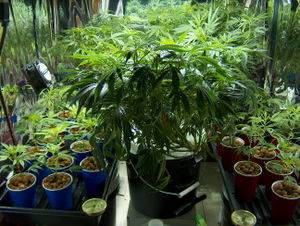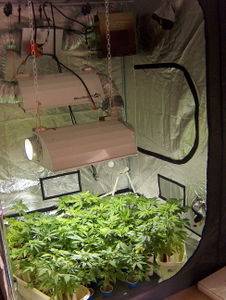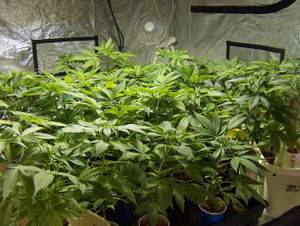-
Happy Birthday ICMag! Been 20 years since Gypsy Nirvana created the forum! We are celebrating with a 4/20 Giveaway and by launching a new Patreon tier called "420club". You can read more here.
-
Important notice: ICMag's T.O.U. has been updated. Please review it here. For your convenience, it is also available in the main forum menu, under 'Quick Links"!
You are using an out of date browser. It may not display this or other websites correctly.
You should upgrade or use an alternative browser.
You should upgrade or use an alternative browser.
Understanding Inorganic Salts and Their Relationship to Plant Nutrition
- Thread starter Grat3fulh3ad
- Start date
pray4pistils
Member
inorganic salts + organic help: merits & methods?
inorganic salts + organic help: merits & methods?
Hey, H3ad (and any others confident about this subject). I currently grow with Flora Nova nutes and then add amendments. Those are minor doses of CalMag plus Hygrozyme, Floralicious+, and Florablend. Every now and then I also add molasses + mycorrizhae fungus and AN's Piranha bacteria. Of those, I think only the CalMag (100% salt) throws off the nute ratios. The tap water I use is fairly soft (shows up as 0ppm on my Blue Labs truncheon) and I let it sit 24 hours before use to let the chorine out.
Now, as I understand it, a plant will accept nutrients in any form that they are *available*. Salts are instantly available and are basically "poured" right into the plant. On the other hand, organic nutrients are actually fed to the soil where the microherd (bacteria and fungus) digest them and only then make available for roots to absorb.
My question is how does one take advantage of chemical salt's convenience but also set up a microherd support base with organic amendments? With this strategy I reason that a moderately experienced grower can ensure maximum growth rate, take advantage of organic flavor/health, and also widen the margin of error as far as burning is concerned, etc.
The pray4pistils garden seems happy enough, but I'd like to optimize everything! That requires actual understanding of the principles involved. Please lay some knowledge on us, gurus.
Thank you,

Mom and the kids



Last batch of youngin's just after going under the 400W CMH
inorganic salts + organic help: merits & methods?
Hey, H3ad (and any others confident about this subject). I currently grow with Flora Nova nutes and then add amendments. Those are minor doses of CalMag plus Hygrozyme, Floralicious+, and Florablend. Every now and then I also add molasses + mycorrizhae fungus and AN's Piranha bacteria. Of those, I think only the CalMag (100% salt) throws off the nute ratios. The tap water I use is fairly soft (shows up as 0ppm on my Blue Labs truncheon) and I let it sit 24 hours before use to let the chorine out.
Now, as I understand it, a plant will accept nutrients in any form that they are *available*. Salts are instantly available and are basically "poured" right into the plant. On the other hand, organic nutrients are actually fed to the soil where the microherd (bacteria and fungus) digest them and only then make available for roots to absorb.
My question is how does one take advantage of chemical salt's convenience but also set up a microherd support base with organic amendments? With this strategy I reason that a moderately experienced grower can ensure maximum growth rate, take advantage of organic flavor/health, and also widen the margin of error as far as burning is concerned, etc.
The pray4pistils garden seems happy enough, but I'd like to optimize everything! That requires actual understanding of the principles involved. Please lay some knowledge on us, gurus.
Thank you,
Mom and the kids
Last batch of youngin's just after going under the 400W CMH
Salts are only 'instantly available' when their concentration in the solvent is low enough to allow dissociation. Growing in coco is an excellent example of growing using salts, but also having an 'organic support system' in place. Coco naturally supports trichoderma growth, for example, and can be colonized by other beneficials as well.Hey, H3ad (and any others confident about this subject). I currently grow with Flora Nova nutes and then add amendments. Those are minor doses of CalMag plus Hygrozyme, Floralicious+, and Florablend. Every now and then I also add molasses + mycorrizhae fungus and AN's Piranha bacteria. Of those, I think only the CalMag (100% salt) throws off the nute ratios. The tap water I use is fairly soft (shows up as 0ppm on my Blue Labs truncheon) and I let it sit 24 hours before use to let the chorine out.
Now, as I understand it, a plant will accept nutrients in any form that they are *available*. Salts are instantly available and are basically "poured" right into the plant. On the other hand, organic nutrients are actually fed to the soil where the microherd (bacteria and fungus) digest them and only then make available for roots to absorb.
When introducing microlife into your system, what are your goals?My question is how does one take advantage of chemical salt's convenience but also set up a microherd support base with organic amendments? With this strategy I reason that a moderately experienced grower can ensure maximum growth rate, take advantage of organic flavor/health, and also widen the margin of error as far as burning is concerned, etc.
The pray4pistils garden seems happy enough, but I'd like to optimize everything! That requires actual understanding of the principles involved. Please lay some knowledge on us, gurus.
Thank you,
The main role of microlife in an organic system is to convert unusable organic compounds into usable inorganic ones... This role is unnecessary when using readily available nutrients...
There are, however, also enzymes which are by-products of the life cycle of some beneficials... adding these could provide usable benefits to your garden... The main concern would be in providing the microlife with organic material for food... In the coco example, the trichoderma feed on the coco.
However, you don't want to provide food for the wrong kind of microlife... Pythium for example...
Matanuskan Flo
Member
thanx grat3fulh3ad, very informative thread.
pray4pistils
Member
Okay, I lost track of this thread but remain interested in the informed answers!
At this point my goals are now to expand on the success that I got some time after asking these questions. I went ahead and did some FloraNova + organics runs with clones in a very aerated hempy SOG.
Right, and it's these by products that seem to be relieving stress (transplant, heat, drought) in general. Taste and aroma have also improved. Output isn't all that different until I get down to the last two weeks where I'd ordinarily be flushing. At that point I just go 100% organic and let the plant consume any leftover chemicals. Since the girls are fed to the end, they pump out a little bit more weight.
What foods are you suggesting that I should avoid? For the record, I brew aerated tea in my reservoir. My recent success has been with this basic recipe:
AN Iguana Juice (half strength)
AN Tarantula
Floralicious Plus (half strength)
FloraNectar
Hygrozyme
fulvic acid
dried kelp
earthworm castings (held in a nylon stocking)
coffee grinds (" ")
alfalfa pellets (" ")
urine (pee'd by me directly into the reservoir)
Previously I poured all this into a hempy set up. Now I'm brewing the tea directly in my ebb & flow bucket system's 55gal reservoir. There's no slime, foul odors, or issues in general. -just lots of foam and an earthy fragrance. The pH jumps to ~6.8 in the hydro range until the batch starves or I kill it with H202, but that just ain't an issue with organics. On the last (hempy) run I found a score of fat/juicy earthworms in the perlite-based mix.
When introducing microlife into your system, what are your goals?
At this point my goals are now to expand on the success that I got some time after asking these questions. I went ahead and did some FloraNova + organics runs with clones in a very aerated hempy SOG.
There are, however, also enzymes which are by-products of the life cycle of some beneficials... adding these could provide usable benefits to your garden...
Right, and it's these by products that seem to be relieving stress (transplant, heat, drought) in general. Taste and aroma have also improved. Output isn't all that different until I get down to the last two weeks where I'd ordinarily be flushing. At that point I just go 100% organic and let the plant consume any leftover chemicals. Since the girls are fed to the end, they pump out a little bit more weight.
The main concern would be in providing the microlife with organic material for food... However, you don't want to provide food for the wrong kind of microlife... Pythium for example...
What foods are you suggesting that I should avoid? For the record, I brew aerated tea in my reservoir. My recent success has been with this basic recipe:
AN Iguana Juice (half strength)
AN Tarantula
Floralicious Plus (half strength)
FloraNectar
Hygrozyme
fulvic acid
dried kelp
earthworm castings (held in a nylon stocking)
coffee grinds (" ")
alfalfa pellets (" ")
urine (pee'd by me directly into the reservoir)
Previously I poured all this into a hempy set up. Now I'm brewing the tea directly in my ebb & flow bucket system's 55gal reservoir. There's no slime, foul odors, or issues in general. -just lots of foam and an earthy fragrance. The pH jumps to ~6.8 in the hydro range until the batch starves or I kill it with H202, but that just ain't an issue with organics. On the last (hempy) run I found a score of fat/juicy earthworms in the perlite-based mix.

Great thread, very informative & i will endevour to understand it & more! Thanks guys! Giving me some great ideas!
I add molassas to my soiless mix to provide food for the microherd...is it me or did I discern that the nutrient salts kill the bacteria?
Then is adding molassas counterproductive?
It has always seemed to me that molassas provides the necessary simple sugars that the micro's feed on.
Then is adding molassas counterproductive?
It has always seemed to me that molassas provides the necessary simple sugars that the micro's feed on.
I add molassas to my soiless mix to provide food for the microherd...is it me or did I discern that the nutrient salts kill the bacteria?
Then is adding molassas counterproductive?
It has always seemed to me that molassas provides the necessary simple sugars that the micro's feed on.
you don't need a microherd unless you're feeding with big organic sourced molecules which must be digested into salts before the plant can use them. salts are already ready already. salts do not kill anything when used properly.
not even to fight the bad microlife?? (pithyum, fusarium, etc..)
This was what I believed ...
So, at this point; and using GH Flora series, should I just dump the trichoderma to the bin and use only Mineral Magic for this purpose???
This is always a big question for me.
(in the rest I agree, if you have chelates in the mix, you don't need microlife to "disgest" it, etc).
Thanks for the thread, you made me go coco loco time ago ...
This was what I believed ...
So, at this point; and using GH Flora series, should I just dump the trichoderma to the bin and use only Mineral Magic for this purpose???
This is always a big question for me.
(in the rest I agree, if you have chelates in the mix, you don't need microlife to "disgest" it, etc).
Thanks for the thread, you made me go coco loco time ago ...

not even to fight bad ones.
I'm sure there are dozens of growers here who could tell you instances of root rot in a 100% mineral/salt derived nutrient formula.
I'm sure there are dozens of growers here who could tell you instances of root rot in a 100% mineral/salt derived nutrient formula.
G
gloryoskie
.
JustunUther
New member
After reading the beginning posts of this thread, I was reaching for a seat belt w one hand and scrolling to locate Chptr 1- the first "big" post. Sweet contribution... it just seemed like an intro page for what wishful thinking had me sure was a thread I'd likely bookmark, study and reference for a long time to come. Grat - your presentation was just complicated enough to demand my close attention while still making data input seem fun & productive. The worst data input terminal I know of is between my ears - BUT only for info I'm not interested in or passionate about. Switching to different media after 25+ years in soil has me very hungry for knowledge to customize feed all over again.
I'd like to study a lot more about this specific subject: salts, formulations, pros/cons of various sources & how to go really well instead of going really wrong by mixing wrong things at wrong times. Since its an older thread, maybe I should just ask for suggestions about further reading that mimics Grat's technique/teaching style.
Thanks for those posts, Grat. This was an inspiring reminder/reality check about long term to-dos that I've already waited to long to handle.
I'd like to study a lot more about this specific subject: salts, formulations, pros/cons of various sources & how to go really well instead of going really wrong by mixing wrong things at wrong times. Since its an older thread, maybe I should just ask for suggestions about further reading that mimics Grat's technique/teaching style.
Thanks for those posts, Grat. This was an inspiring reminder/reality check about long term to-dos that I've already waited to long to handle.
Vandenberg
Active member
This is well presented and informative...
This is well presented and informative...
A 2020 bump.
Vandenberg
This is well presented and informative...
A 2020 bump.

Vandenberg



